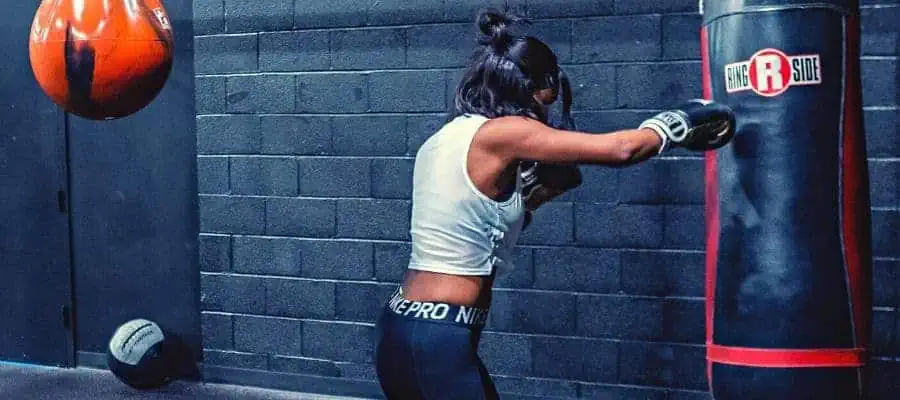In martial arts, some punches are somehow similar to each other. I would like to compare them in terms of strength, speed of execution, and effectiveness in the fight. In this post, I would like to compare the right cross with the long-range right hook.
To compare the long-range right hook to the right cross, let’s look at the techniques of these punches.
| Punch Attributes | Cross | Long Range Right Hook |
|---|---|---|
| Power | High | High |
| Speed | Med | High |
| Predictability | Low | High |
| Counterattack Possibility | High | High |
| Knockout Possibility | High | Med |
| Hard Technique Execution | High | Low |
Long Range Right Hook

Long Range Right Hook is a side punch, which is executed at a long distance and therefore has several differences from the classic hook. According to the standard execution technique, the side punch is ideally performed at close range. It is applied with the elbow at an angle of 90 degrees and the fist in the form of a holding cup.
Because of the fist in the position of holding a cup, it is difficult for a boxer to make such a punch technically correct. At the middle distance, it will be very difficult and at a long distance, it is simply not possible to do it. Therefore, the longer the distance, the more technically incorrect the punch will be.
With it, the boxer will increase the swinging for the punch. Accordingly, the punch will be more visible and the boxer’s defense will be more open. To do a long-range right hook, the cup-holding fist technique will not work for us. Here you will need to put your fist parallel to the floor and hit with the first knuckle of the fist, which means the angle of the fist.
The shoulder should snap/turn to the chin a moment before hitting the target. This will help to increase the punching power, add accuracy to it, and protect the chin from a counterattack. As you know, the fighter is most open to the opponent’s counterattack when he is executing a punch.
If the opponent is experienced enough, he will try to take this opportunity to turn the fight in his favor.
Another Long-Range Hook Variation

There is another type of long-range hook that is dangerous to the opponent because of its power. But it is also dangerous for the boxer, who will throw it incorrectly because his defense will be opened during the execution. This punch is called a swing.
The main thing about this punch is that it is delivered not from the side, but from above. In other words, if the usual side punch goes along a horizontal trajectory, the swing comes from above and is directed diagonally down. By landing behind the glove, it hits the jaw.
And in the worst case, it takes down the opponent’s glove and prepares the area for a series of punches.
Pros

Powerful Punch
With the right technique and the right timing, this punch can knock out the opponent.
Hidden Punch
A long-range right hook and swing are unusual and hidden punches. They are not easy to recognize and to have time to defend against them. Usually, these punches cause a lot of damage because the opponent’s defense was not prepared for them.
Cons

Good Technique Is Required
Because the long-range right hook or swing is not a standard punch, it requires good and accurate technique. If the technique is not at a high level, it won’t work perfectly. Or even worse, it will be slow enough that the opponent will see it and dodge from it or counterattack.
I think it’s pretty clear to everyone how a counterattack can end up on an open defense.
Opens The Defense
When this punch is executed incorrectly, it opens up the defense very badly. Unfortunately, the execution of this punch creates a large window for a counterattack. It’s because the boxer’s defense opens up considerably. Many boxers use these punches very rarely and only when they are most comfortable with their execution.
Besides, many boxers prepare their escape from a possible counterattack to this punch. They slip to the side or bob and weave after a punch to cut the risk of a counterpunch. Bob and weave mean that at the moment of the opponent’s punch, the fighter quickly bends his legs and at the same time shifts the body to the right or left.
Right Cross

Right сross is a common right straight punch (in the right stance). It is a standard punch that everyone from the beginner to the professional knows. It is usually executed after a jab or a series of punches. The specifics of this punch are its simple and natural motion mechanics.
It requires no additional twisting, moving, or transferring of body weight. The arm naturally flies straight along the trajectory and returns the same way. All that needs to be considered is the proper rotation of the right foot and shoulder at the finish of the punch. This is needed to protect your chin and add power to your cross.
Pros

Technique
Cross is a very technical punch because of its naturalness, as I said above. It is much easier and more natural to throw your arms in a straight line. So, it is much easier to master a great technique than with other punches, such as hooks or uppercuts.
Power
This punch is also very strong because of the inclusion of foot, hip, and shoulder rotation, which gives it great punching power.
Speed
This punch is much easier to master because of its technicality and naturalness than other punches. Besides, the flight trajectory of the hand is much shorter than that of the long-range right hook. This reduces the execution time until the target is reached.
Cons

Predictability
Strangely enough, the right straight punch is also the most predictable in boxing. A large number of fighters after a jab or double jab sooner or later throw a right straight punch. This is the most typical way to end a punching combination. What usually happens is that the series of punches ends with a quick and powerful punch.
Almost no one has ever seen a boxer finish a combination with a jab. Because of its predictability, almost all boxers will be prepared to defend against it.
Rarely A Knockout Punch
Because the fighters are prepared to meet a right straight, their defense can take the force of that punch. Maximum what will happen is that the opponent will be out of balance, but probably not knocked out. This can happen, of course, if the punch is delivered to an open defense.
Counterattack Possibility
There is a lot of attack escaping and counterattacks on the right side punches. An experienced opponent for sure developed various techniques, such as a check-hook or a dodge with a liver punch. This way they can successfully counterattack your punches.
Conclusion
As we can see, both of these punches are quite strong, and each has disadvantages and advantages. I think it will be helpful to work on both of these techniques. Also, if possible and from time to time, try to find the right timing to execute them in the fight. This, of course, requires sparring and technique improvement on pads work.
I hope this article was helpful to you. Good luck in boxing.
Recent Posts
What is Manachai's Fighting Style? Unveiling Muay Thai Mastery
Manachai, a celebrated figure in the Muay Thai world, has captivated audiences with his exemplary martial prowess. Hailing from the heartlands of Thailand, his name is synonymous with the art of...
What Was Chamuekpet Hapalang's Fighting Style? Unveiling Techniques
Chamuekpet Hapalang was a renowned figure in the world of Muay Thai (record 200-48-2), embodying a fusion of Muay Bouk and Muay Khao styles. Originating from Thailand, the art of Muay Thai is known...
